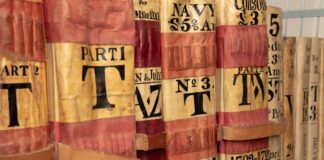What was the highest priced scripophily sale at auction in 2019? Was it a previously unseen Chinese Imperial bond, a pioneering British railway share, or one of Apple’s founders shares personally signed by Steve Jobs? None of these. It was a Dutch bond from the 17th century, and it was sold in HWPH’s 52nd Auction, at Würzburg on 4 May 2019.
Top sale in 2019, reported by the International Bond and Share Society (IBSS), was a 6.5% bond issued by the Vereenigde Oost-Indische Compagnie, also known as the VOC (Dutch East India Company). The bond, unnumbered and pen cancelled, measures about 32 x 21 cm. It was printed on handmade paper and issued, with signatures, on 25 April 1623 for 500 Flemish Pounds.
If you want to know why this VOC bond certificate achieved a top price at auction, then you need to know what kind of company the VOC was.
The VOC started as a Dutch trading company. A number of competing pre-companies from the Republic of the Seven United Netherlands formed in 1602 the VOC with a capital of 6,440,200 guilders. The new company paid 25,000 guilders for a 21-year monopoly to explore, colonize and trade with the East Indies.

The VOC built its own ships in Amsterdam, Middelburg, Zaandam but also near Batavia (Jakarta). Tsar Peter I of Russia worked incognito as a ship’s carpenter at the VOC’s shipyards in the Netherlands.

The company was involved in the production and trade of East Indian spices, sugarcane from Formosa, wine from South Africa and lots more. The Shoguns of Japan allowed the VOC as the only European partner to conduct business with. Japanese porcelain, then much in demand, came to Europe on a VOC ship.
In its overseas colonies, the VOC had governmental powers, including the ability to wage war, imprison and execute convicts. In some parts of the world, the VOC produced its own gunpowder like in its refinery at Chhapra, West Bengal, where it processed saltpeter from Patna.
In order to maintain control in and maximize profits from its overseas destinations the VOC did not hesitate to suppress locals with or without the help of the local rulers. At some point in the 17th century the VOC controlled all harbors in Asia. The company commanded then over hundreds of ships, a quarter of them warships, tens of thousands of employees and lead a private army of 10,000 soldiers.
The fourth war between England and The Netherlands (1780-1784) brought the VOC in problems. Its ships were unable to arrive safely at the company’s European harbors. The English had captured many VOC trading posts. VOC ships, loaded with valuable merchandise, were hijacked. The company lost money.
When the French invaded The Netherlands in 1795, the VOC could no longer operate. Almost 200 years after its founding, the company was liquidated in 1798.

The Vereenigde Oost-Indische Compagnie was one of the first globally operating corporations. Being the first company listed on a stock exchange it applied a business model that still exists today.
The VOC founded trading posts and production settlements in today’s South Africa, Mauritius, India, Malaysia, Indonesia, Thailand, Vietnam, Taiwan, China and Japan. Therefore, this VOC bond is one of the oldest known scripophily documents related to these countries.
Regardless its military operations, the company brought European ideas, technology and art to Asia, but equally the other way around. It opened up the world to the world.
Our bond certificate, lot 632 in the auction, was expected to realize at least €30,000. In fact, it turned out to be the best-selling item in the sale and the most expensive one sold at auction in 2019. Lot 632 was sold at €46,000, and that’s without the buyer’s premium.
Here you can find out more about the most expensive share sold in 2018.
And here we will gather all these scripophily records year by year.
The author Franky Leeuwerck publishes numerous articles on his blog and maintains an Internet Scripophily Museum of Computing.
There you can also find an exciting survey on collectors’ preferences!





